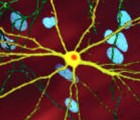Weight loss is an important complication of Huntington’s disease (HD), however the mechanism for weight loss in HD is not entirely understood. Mutant huntingtin is expressed in the gastrointestinal (GI) tract and, in HD mice, mutant huntingtin inclusions are found within the enteric nervous system along the GI tract. A reduction of neuropeptides, decreased mucosal thickness and villus length, as well as gut motility impairment, have also been shown in HD mice. We therefore set out to study gastric mucosa of patients with HD, looking for abnormalities of mucosal cells using immunohistochemistry. In order to investigate possible histological differences related to gastric acid production, we evaluated the cell density of acid producing parietal cells, as well as gastrin producing cells (the endocrine cell controlling parietal cell function). In addition, we looked at chief cells and somatostatin-containing cells. In gastric mucosa from HD subjects, compared to control subject biopsies, a reduced expression of gastrin (a marker of G cells) was found. This is in line with previous HD mouse studies showing reduction of GI tract neuropeptides.
Huntington’s disease (HD) is a neurodegenerative illness, where selective neuronal loss in the brain caused by expression of mutant huntingtin protein leads to motor dysfunction and cognitive decline in addition to peripheral metabolic changes. In this study we confirm our previous observation of impairment of lactate-based hepatic gluconeogenesis in the transgenic HD mouse model R6/2 and determine that the defect manifests very early and progresses in severity with disease development, indicating a potential to explore this defect in a biomarker context. Moreover, R6/2 animals displayed lower blood glucose levels during prolonged fasting compared to wild type animals.
Objective: To assess effects of a two year intensive, multidisciplinary rehabilitation program for patients with early- to mid-stage Huntington’s disease.
Design: A prospective intervention study.
Setting: One inpatient rehabilitation center in Norway.
Subjects: 10 patients, with early- to mid-stage Huntington’s disease.
Interventions: A two year rehabilitation program, consisting of six admissions of three weeks each, and two evaluation stays approximately three months after the third and sixth rehabilitation admission. The program focused on physical exercise, social activities, and group/teaching sessions.
Main outcome measures: Standard measures for motor function, including gait and balance, cognitive function, including MMSE and UHDRS cognitive assessment, anxiety and depression, activities of daily living (ADL), health related quality of life (QoL) and Body Mass Index (BMI).
Results: Six out of ten patients completed the full program. Slight, but non-significant, decline was observed for gait and balance from baseline to the evaluation stay after two years. Non-significant improvements were observed in physical QoL, anxiety and depression, and BMI. ADL-function remained stable with no significant decline. None of the cognitive measures showed a significant decline. An analysis of individual cases revealed that four out of the six participants who completed the program sustained or improved their motor function, while motor function declined in two participants. All the six patients who completed the program reported improved or stable QoL throughout the study period.
Conclusion: Our findings suggest that participation in an intensive rehabilitation program is well tolerated among motivated patients with early to mid-stage HD. The findings should be interpreted with caution due to the small sample size in this study.
Huntington’s disease (HD), an autosomal dominant neurodegenerative syndrome, has a world-wide distribution. An estimated 2.5-10/100,000 people of European ancestry are affected with HD, while the Asian populations have lower prevalence (0.6-3.8/100,000). The epidemiology of HD is not well described in India, and the distribution of the pathogenic CAG expansion, and the associated haplotype, in this population needs to be better understood. This study demonstrates a distribution of CAG repeats, at the HTT locus, comparable to the European population in both normal and HD affected chromosomes. Further, we provide an evidence for similarity of the HD halpotype in Indian sample to the European HD haplogroup.
Development of six large nodules of solid tissue after bilateral human fetal striatal transplantation in four Huntington’s disease patients has raised concern about the safety of this experimental therapy in our setting. We investigated by serial MRI-based volumetric analysis the growth behaviour of such grafts. After 33-73 months from transplantation the size of five grafts was stable and one graft showed a mild decrease in size. Signs neither of intracranial hypertension nor of adjuctive focal neurological deficit have ever been observed. This supports long-term safety of the grafting procedure at our Institution.
Huntington’s disease (HD) is a late-onset, slowly progressing neurodegenerative disorder caused by an expansion of glutamine repeats. The YAC128 mouse model has been widely used to study the progression of HD symptoms, but little is known about synaptic alterations in very old animals. The present experiments examined synaptic properties of striatal medium-sized spiny neurons (MSNs) in 16 month-old YAC128 mice. These mice were crossed with mice expressing enhanced green fluorescent protein (EGFP) under the control of either D1 or D2 dopamine receptor promoters to identify MSNs originating the direct and indirect pathways, respectively. The input-output curves of evoked excitatory postsynaptic currents mediated by activation of the α-amino-3-hydroxy-5-methyl-4-isoxazolepropionic acid (AMPA) or N-methyl-D-aspartate (NMDA) receptors were reduced in MSNs in both pathways. In the presence of DL-threo-β-Benzyloxyaspartic acid (DL-TBOA), a glutamate transporter blocker used to increase activation of extrasynaptic receptors, NMDA receptor-mediated currents displayed altered amplitudes, longer decay times, and greater charge (response areas) in both direct and indirect pathway MSNs in YAC128 mice compared to wildtype controls. Amplitudes were significantly increased, primarily in direct pathway MSNs while normalized areas were significantly increased only in indirect pathway MSNs, suggesting that the two types of MSNs are affected in different ways. It may be that indirect pathway neurons are more susceptible to changes in glutamate transport. Taken together, the present findings demonstrate differential alterations in synaptic versus extrasynaptic NMDA receptors in both direct and indirect pathway MSNs in late HD, which may contribute to the dysfunction and degeneration in both pathways.
Huntington’s disease (HD) is a fatal neurodegenerative disorder caused by a polyglutamine expansion in the huntingtin (HTT) protein. The expression of mutant HTT in the baker’s yeast Saccharomyces cerevisiae recapitulates many of the cellular phenotypes observed in mammalian HD models. Mutant HTT aggregation and toxicity in yeast is influenced by the presence of the Rnq1p and Sup35p prions, as well as other glutamine/asparagine-rich aggregation-prone proteins. Here we investigated the ability of a subset of these proteins to modulate mutant HTT aggregation and to substitute for the prion form of Rnq1p. We find that overexpression of either the putative prion Ybr016wp or the Sup35p prion restores aggregation of mutant HTT in yeast cells lacking the Rnq1p prion. These results indicate that an interchangeable suite of aggregation-prone proteins regulates mutant HTT aggregation dynamics in yeast, which may have implications for mutant HTT aggregation in human cells.
We have previously reported the genetic correction of Huntington’s disease (HD) patient-derived induced pluripotent stem cells using traditional homologous recombination (HR) approaches. To extend this work, we have adopted a CRISPR-based genome editing approach to improve the efficiency of recombination in order to generate allelic isogenic HD models in human cells. Incorporation of a rapid antibody-based screening approach to measure recombination provides a powerful method to determine relative efficiency of genome editing for modeling polyglutamine diseases or understanding factors that modulate CRISPR/Cas9 HR.
Diffusion tensor imaging (DTI) has shown microstructural abnormalities in patients with Huntington’s Disease (HD) and work is underway to characterise how these abnormalities change with disease progression. Using methods that will be applied in longitudinal research, we sought to establish the reliability of DTI in early HD patients and controls. Test-retest reliability, quantified using the intraclass correlation coefficient (ICC), was assessed using region-of-interest (ROI)-based white matter atlas and voxelwise approaches on repeat scan data from 22 participants (10 early HD, 12 controls). T1 data was used to generate further ROIs for analysis in a reduced sample of 18 participants. The results suggest that fractional anisotropy (FA) and other diffusivity metrics are generally highly reliable, with ICCs indicating considerably lower within-subject compared to between-subject variability in both HD patients and controls. Where ICC was low, particularly for the diffusivity measures in the caudate and putamen, this was partly influenced by outliers. The analysis suggests that the specific DTI methods used here are appropriate for cross-sectional research in HD, and give confidence that they can also be applied longitudinally, although this requires further investigation. An important caveat for DTI studies is that test-retest reliability may not be evenly distributed throughout the brain whereby highly anisotropic white matter regions tended to show lower relative within-subject variability than other white or grey matter regions.
Huntington’s disease is a neurodegenerative disorder caused by mutations in the CAG tract of huntingtin. Several studies in HD cellular and rodent systems have identified disturbances in cyclic nucleotide signaling, which might be relevant to pathogenesis and therapeutic intervention. To investigate whether selective phosphodiesterase (PDE) inhibitors can improve some aspects of disease pathogenesis in HD models, we have systematically evaluated the effects of a variety of cAMP and cGMP selective PDE inhibitors in various HD models. Here we present the lack of effect in a variety of endpoints of the PDE subtype selective inhibitor SCH-51866, a PDE1/5 inhibitor, in the R6/2 mouse model of HD, after chronic oral dosing.



